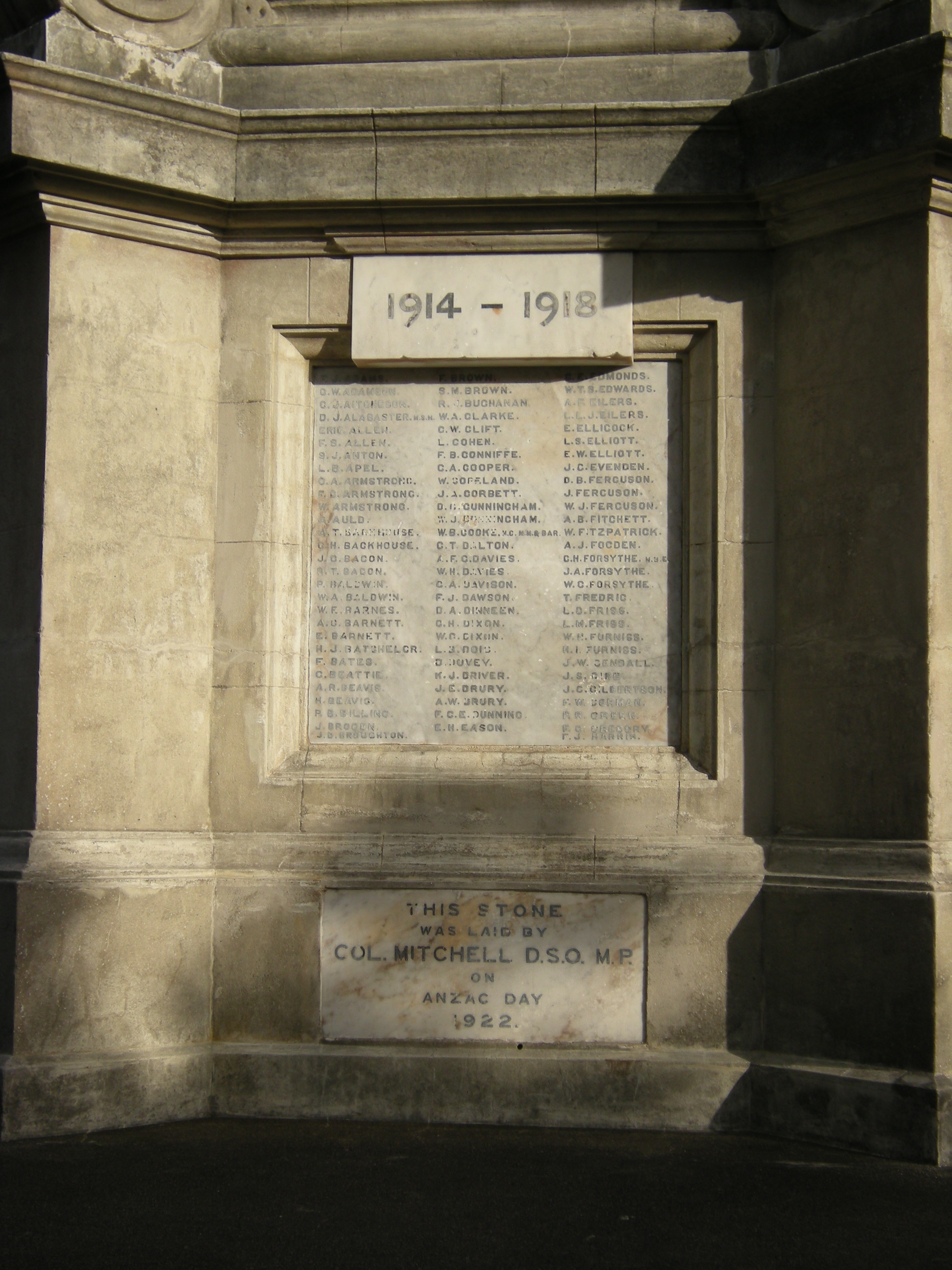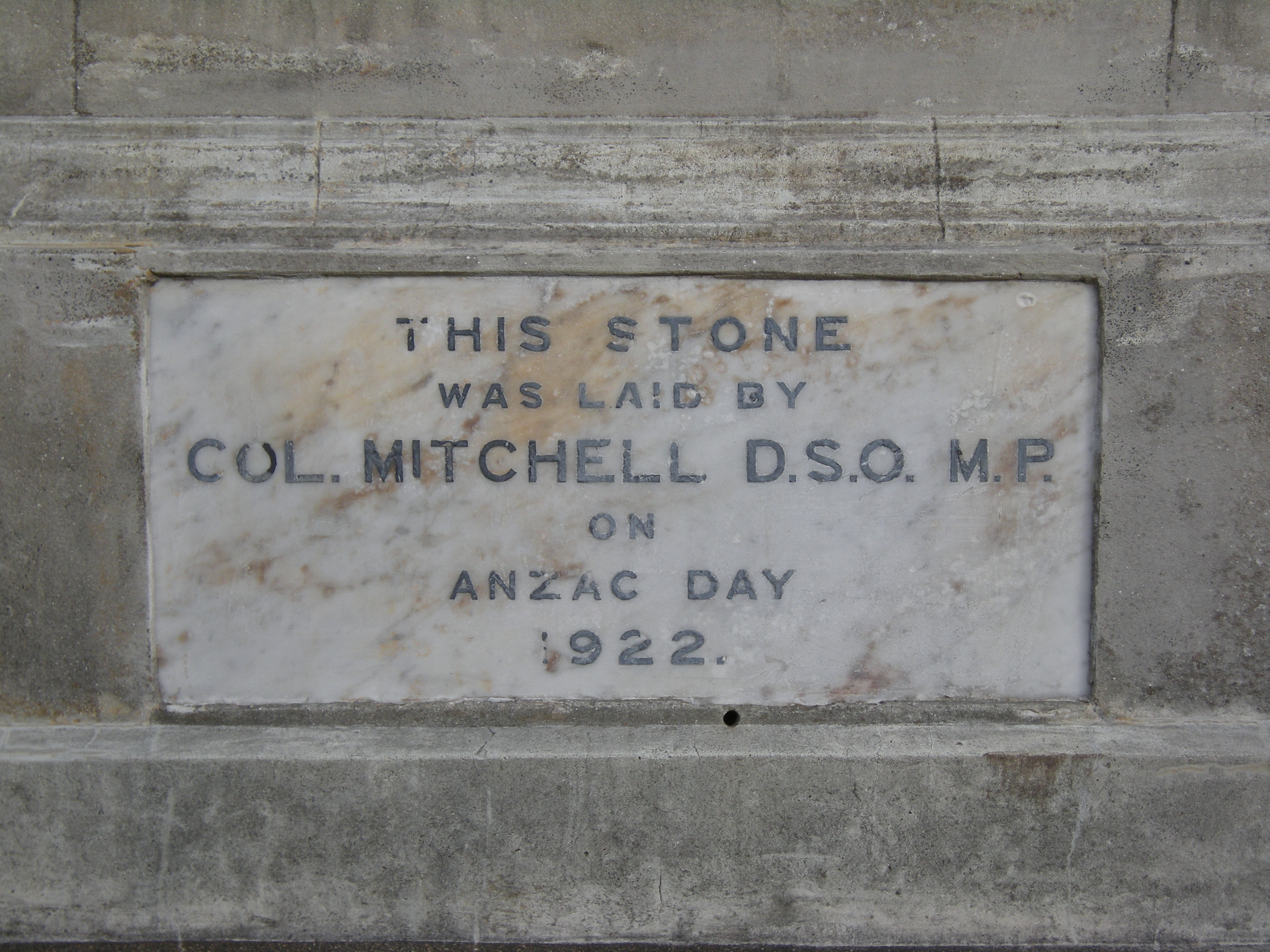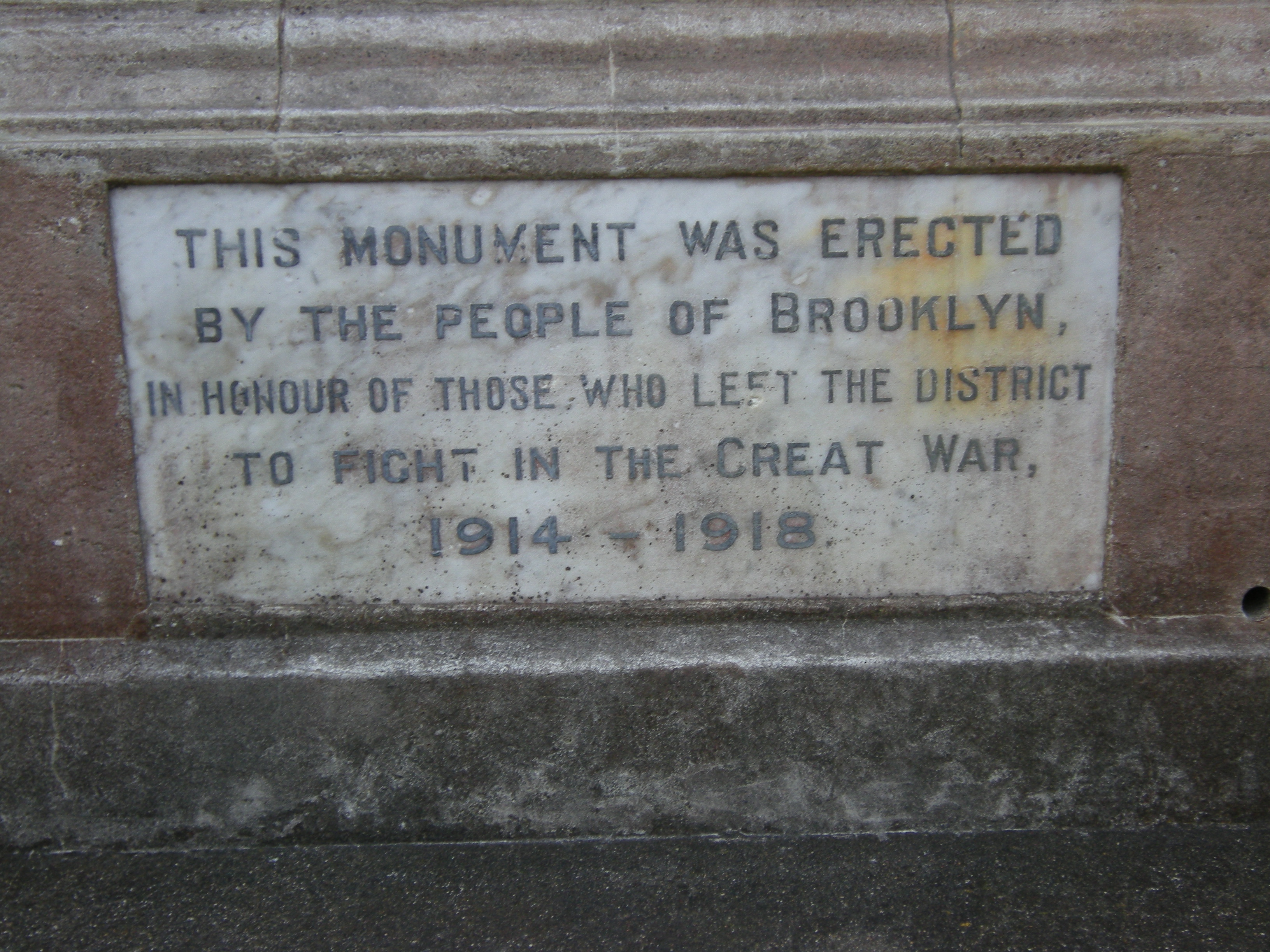Brooklyn War Memorial
Heritage object, Sugarloaf Hill Memorial








Image: WCC, 2014

Image: WCC, 2014
-
Constructed
1922 - 1923
-
-
Architect(s)
-
Builder(s)
Unknown
-
The Brooklyn War Memorial is a good representative example of an early 20th century civic monument.
It has considerable townscape value for its prominent site overlooking Brooklyn, and commands views across to Mt Victoria, Wellington Harbour and beyond to the Hutt Valley.
The memorial was commissioned by the local Returned Services Association (RSA) who raised money to fund construction and maintenance from the local community. It serves as a local memorial to those who had left Brooklyn to fight in World War I, and commemorates the “fallen in all wars.”
The memorial is a focus of community sentiment and connection, particularly for those who knew, or share common ancestry, with those who are named on the memorial, and to those who have a connection to military service. This sense of sentiment and connection is likely to be renewed during the upcoming centenary of the World War I. -
Downloadable(s)
-
close
History
-
The Brooklyn War Memorial was built to commemorate Brooklyn’s World War I servicemen. It was planned and constructed through the efforts of the Brooklyn Returned Services Association and the people of Brooklyn. In just two years following the end of World War I they raised £700 for its construction. The memorial trustees maintained the memorial for 16 years until they passed it over to the Wellington City Council. The council has maintained the memorial and its surrounds ever since.
New Zealand’s military involvement in World War I (1914 – 1918) was extensive, given the size of this country and the relatively small number of men it could send to war. The significance of World War I in shaping New Zealand’s national identity is a much debated subject but the immediate impact of the war was the sheer loss of life, which left virtually no family untouched in some way. The grief manifested itself in the building of hundreds of memorials in towns and cities all over New Zealand, much as it had done, but on a smaller scale, following the South African Wars.
The movement to build a war memorial in Brooklyn began soon after the end of World War I. On 27 August 1919 a deputation from the Brooklyn Returned Services Association waited on the WCC’s Reserves Committee, seeking permission to build a memorial on Sugarloaf Hill. Sugarloaf Hill was once part of John Fitchett’s farm in Brooklyn and was set aside as a reserve in 1902 by the Melrose Borough Council, later adsorbed by the Wellington City Council. An early design – an obelisk – appears in a council file and was approved, but not built. Obelisks were a popular design of that era and are said to account for approximately 30% of all World War I memorials constructed in New Zealand. The Brooklyn RSA eventually decided against an obelisk and instead chose a monument that combined an elaborate pedestal and carved marble statue. The latter is a lone soldier, hat in hand, looking over his shoulder to the right.
The foundation stone was laid on Anzac Day, 25 April 1922 by (Colonel) George Mitchell M.P., who was also the president of the memorial committee and later a trustee of the monument. A telegram was sent by the Governor General Viscount Jellicoe apologising for his absence. The memorial was unveiled on the 23rd September of the following year. On this occasion Viscount Jellicoe was in attendance along with the acting Prime Minister Sir Francis Bell, the Mayor Robert Wright and several MPs and prominent clergy. The unveiled memorial listed exactly 303 men’s names and of them 48 had been killed. For the next 80 years an Anzac Day procession, which generally included a band and a throng of locals, marched up the steep incline of Todman Street to the memorial for a commemorative service.
The memorial committee had raised £700 for the fund to build and maintain the structure, a considerable sum for the time. George Mitchell and Matthew Thew, of the Brooklyn RSA, were appointed as trustees to care for the memorial. They remained trustees for much of the next two decades. In 1939 Matthew Thew, who was by then the sole remaining trustee, handed the memorial to the WCC along with the remainder of the trust account which contained £43. It has remained in council ownership ever since.
The WCC became responsible for the maintenance of the monument as well as the surrounding reserve. They sealed the rough path from Mitchell Street, installed a streetlight in 1940, paving in 1941, and steps to a flagpole in 1965. The memorial was updated “to commemorate the fallen in all wars lest we forget” in 1970, but this marble plaque was vandalised and replaced in 1977.
In 1975 the memorial was included on an early register of historic places compiled by the WCC for its district scheme. It became an ‘object of historic interest’ and plasterwork and cappings were repaired. For all that, maintenance seems to have been haphazardly applied; a picture taken in 1976 shows considerable graffiti evident on the shaft of the monument. In 1987 a survey of war memorials in the city found that every one was in need of maintenance of some sort. In the case of the Brooklyn memorial water blasting ($250) and unspecified plaster and repairs ($500) were identified as priorities.
The Brooklyn RSA and Brooklyn Progressive Association have continued to press the council to care for the memorial, and the former in particular have made regular contributions to its maintenance. A recent example from 1999 was the payment of half the bill of $1600 to clean the memorial of graffiti, a scourge over the latter life of the memorial. Other recent repairs and maintenance have been guided by the 2002 conservation plan and include cleaning, re-plastering, and structural repairs to secure the statue. The surrounding trees have been trimmed, and the paths and base of the monument are tidied annually in the weeks prior to ANZAC Day.
In recent years the veteran’s parade from central Brooklyn to the war memorial has been curtailed, as the walk up Todman Street proved too difficult for the RSA’s aging members. The Brooklyn War Memorial is, however, likely to be viewed with renewed local interest in the lead-up to the centenary of World War I from 2014 – 18. It is featured on the Te Papa ‘World War One Memorial Project’ website and the Ministry for Culture and Heritage website – NZ History.net
-
Modifications
close
-
1922
-
Foundation stone laid
-
1923
-
Unveiled
-
c.1939 - 1941
-
Paving and paths
-
1965
-
Flagpole steps added
-
1970
-
New marble plaque added. New lighting.
-
1977
-
Replacement plaque.
-
unknown
-
Half-orbs by the concrete path were removed
-
2002 - 2003
-
Maintenance was carried out as per the 2002 conservation plan. This work included cleaning, re-plastering, and structural repairs to secure the statue. The half-orbs were replaced at this date.
-
-
Occupation History
close
Not assessed
-
The Brooklyn War Memorial was built to commemorate Brooklyn’s World War I servicemen. It was planned and constructed through the efforts of the Brooklyn Returned Services Association and the people of Brooklyn. In just two years following the end of World War I they raised £700 for its construction. The memorial trustees maintained the memorial for 16 years until they passed it over to the Wellington City Council. The council has maintained the memorial and its surrounds ever since.
-
close
Architectural Information
-
Building Classification(s)
close
Not assessed
-
Architecture
close
The monument is essentially symmetrical and consists of four discernable parts: The octagonal platform (path and steps), the plinth, the shaft (or column) and the statue.
The marble statue depicts a soldier, or ‘digger’ as he was described in 1923, with his hat off and looking south over his right shoulder. The design style is described as “solider at ease.”
The statue stands on an eight-sided polygonal platform. The polygon sides are unequal and the four ‘square’ sides are approximately twice the length of the four ‘chamfered’ ones. The platform extends past the face of a similarly polygonal shaft (or column) to form a stylised capital that is decorated with dentils and festoons. The polygonal column extends down to a decorative base made up of scrolled brackets on the shorter ‘chamfered’ faces, and with a festoon detail on the wider ‘square’ faces.
The shaft sits on a 16-sided platform (edged with a cornice detail) over a similarly 16-sided plinth. The plinth is made up of four ‘square’ sides that are flanked by four buttresses formed by the ‘extrusion’ of the ‘chamfered’ faces of the shaft. The square faces are recessed to form a panelled ‘frame’ for the list of names of war veterans from the 1914 – 1918 war. These dates are set on a rectangular ‘key-stones’ that are set above the panels of names. One panel is reserved for those who died in 1914 – 1918, and the remaining three panels list the other veterans in alphabetical order. A foundation stone reads… ‘This stone was laid by Col. Mitchell D.S.O M.P. on Anzac Day 1922. ” A second similarly placed stone states that: “This monument was erected by the people of Brooklyn in honour of those who left the district to fight in the Great War 1914 – 1918.”
The column and plinth are made up of cast-in-situ concrete that was poured in a series of lifts. It may be reinforced as there is some evidence of rust-stains, but extent or existence of reinforcement is unknown. The exterior is finished with several layers of cement render, lined out to resemble ashlar stonework. The interior of the shaft, and presumably the plinth, is hollow and the wall thickness is approximately 235mm. Most, if not all, of the decorative pieces were cast off-site and fixed in-situ.
The plinth sits on a platform made up of a path and five steps that form a near-true octagon in plan. The path is bounded by a ring of small square plinths that are topped by half round orbs.
The total height of the monument including the stepped platform is approximately 12.7m.
Architect/Designer
The designer of the monument is unknown, but an inscription on the statue reads as ‘H. Glover’ or ‘H. Clover’.
It is likely that the monument was designed by H. Glover, a monumental mason or sculptor who also created the Te Aro Memorial. He is known to have occupied a workshop on Molesworth Street in 1912 and Kent Terrace from 1913 until 1932. -
Materials
close
Marble statue
Concrete base and plinth clad in cement render
Concrete path and steps
-
Setting
close
The Brooklyn War Memorial is located on the summit of Sugarloaf Hill and commands views across Wellington Harbour towards the Hutt Valley. The statue has townscape value for its prominent position overlooking central Brooklyn and is visible from the school, RSA rooms, community centre and main street (Cleveland Street).
-
Building Classification(s)
close
-
close
Cultural Value
The Brooklyn War Memorial is a good representative example of an early 20th century civic monument.
It has considerable townscape value for its prominent site overlooking Brooklyn, and commands views across to Mt Victoria, Wellington Harbour and beyond to the Hutt Valley.
The memorial was commissioned by the local Returned Services Association (RSA) who raised money to fund construction and maintenance from the local community. It serves as a local memorial to those who had left Brooklyn to fight in World War I, and commemorates the “fallen in all wars.”
The memorial is a focus of community sentiment and connection, particularly for those who knew, or share common ancestry, with those who are named on the memorial, and to those who have a connection to military service. This sense of sentiment and connection is likely to be renewed during the upcoming centenary of the World War I.-
Aesthetic Value
close
-
Architectural
Does the item have architectural or artistic value for characteristics that may include its design, style, era, form, scale, materials, colour, texture, patina of age, quality of space, craftsmanship, smells, and sounds?
The Brooklyn War Memorial is a good representative example of an early 20th century civic monument.
-
Townscape
Does the item have townscape value for the part it plays in defining a space or street; providing visual interest; its role as a landmark; or the contribution it makes to the character and sense of place of Wellington?
The statue has townscape value for its prominent site overlooking Brooklyn, and commands views across to Mt Victoria, Wellington Harbour and beyond to the Hutt Valley.
-
-
Historic Value
close
-
Association
Is the item associated with an important historic event, theme, pattern, phase, or activity?
The Brooklyn War Memorial built as local memorial to those who had left Brooklyn to fight in World War I. It was later updated to “commemorate the fallen in all wars.”
-
Association
Is the item associated with an important person, group, or organisation?
The memorial was commissioned by the local Returned Services Association (RSA) who raised money to fund construction and maintenance from the local community.
-
- Scientific Value close
-
Social Value
close
-
Public Esteem
Is the item held in high public esteem?
The Brooklyn War Memorial is likely to be held in high public esteem. This can be demonstrated by the interest and comments left on the NZ History and Te Papa websites.
-
Symbolic - Commemorative - Traditional - Spiritual
Does the item have symbolic, commemorative, traditional, spiritual or other cultural value for the community who has used and continues to use it?
The memorial has commemorative value as a local record of those who served in World War I, and as a memorial to those who died in all other wars. It was used, for many years, as the site for the local ANZAC Day memorial services.
-
Identity - Sense of Place - Continuity
Is the item a focus of community, regional, or national identity? Does the item contribute to sense of place or continuity?
The memorial has been sited on a prominent hill overlooking Brooklyn for over 90 years and contributes to the sense of place and identity of the local community.
-
Sentiment - Connection
Is the item a focus of community sentiment and connection?
The memorial is a focus of community sentiment and connection, particularly for those who knew, or share common ancestry with those who are named on the memorial, and to those who have a connection to military service. This sense of sentiment and connection is likely to be renewed during the upcoming centenary of the World War I.
-
-
Level of Cultural Heritage Significance
close
-
Representative
Is the item a good example of the class it represents?
The memorial is a good representative example of a local war memorial.
-
Authentic
Does the item have authenticity or integrity because it retains significant fabric from the time of its construction or from later periods when important additions or modifications were carried out?
The monument has retained much of its original built fabric and has had few intrusive modern alterations or repairs
-
Importance
Is the item important at a local, regional, national, or international level?
The Brooklyn War Memorial is a local record of those who served in World War I. It will, however, have a wider resonance as a war memorial, and for those who have a personal connection with those whose names are inscribed.
-
-
Local / Regional / National / International Importance
close
Not assessed
-
Aesthetic Value
close
-
close
Site Detail
-
District Plan Number
6/52
-
Legal Description
Lot 135 DP 1004
-
Heritage New Zealand Listed
Not listed
-
Archaeological Site
Risk unknown
-
Current Uses
unknown
-
Former Uses
unknown
-
Has building been funded
No
-
Funding Amount
Not applicable
-
Earthquake Prone Status
Unknown
-
-
close
Additional Information
-
Sources
close
- Brooklyn war memorial, Ministry for Culture and Heritage, updated 15-Jul-2013
- City Engineer to Town Clerk, 18/07/1941. Town Clerk’s file 60/4289, WCA.
- Evening Post, 20 August 1912; Evening Post, 24 July 1913; Evening Post 14/09/1923; Evening Post, 15 January 1932
- ‘War Memorial: Makara Road and South Makara Road, Makara, Wellington’ NZHPT website accessed November 2013
- Kelly, Michael. ‘Brooklyn War Memorial: Conservation Plan’ a n unpublished conservation plan prepared for the WCC (2002)
- CT 118/144, Land Information New Zealand
- 'The World War One Memorial Project’, Te Papa Website accessed November 2013
- Town Clerk’s file 60/4289 Brooklyn War Memorial, Sugarloaf Hill, WCC Archives
- Technical Documentation close
-
Footnotes
close
Not available
-
Sources
close
Last updated: 9/29/2017 3:08:05 AM
